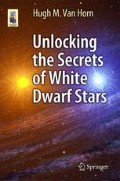Abstract
By the end of the second decade of the twentieth century, the major problem remaining in the early study of stellar structure concerned the source of energy needed to supply the prodigious power output of the stars. Release of chemical energy, such as the burning of a lump of coal, was easily shown to be inadequate. The heat produced by complete combustion of a lump of coal would release only 2–3 × 1011 erg g−1, sufficient to maintain the current luminosity of the Sun only for 60,000–80,000 years. This is much less than the geological age of Earth.
Access this chapter
Tax calculation will be finalised at checkout
Purchases are for personal use only
Notes
- 1.
Pannekoek (1989), p. 397.
- 2.
Chandrasekhar (1939), p. 484.
- 3.
Bethe (1991), p. 246.
- 4.
Ibid.
- 5.
Ibid, pp. 246–253.
- 6.
Gamow (1945).
- 7.
Bethe (1991), pp. 246–253.
- 8.
- 9.
Data from Schwarzschild (1958), p. 264, plotted by the author.
- 10.
Schwarzschild (1958), pp. 199ff.
- 11.
An electron volt, abbreviated “eV,” is a convenient measure of energy for use in discussing electronic levels within atoms. One million electron volts, or 1 MeV, which equals 1.602 × 10−6 erg, turns out to be a more convenient unit of energy to use in measuring nuclear or relativistic energy changes. One kilo electron volt, or 1 keV, equals 1,000 eV or one thousandth of an MeV.
- 12.
Bethe (1991), pp. 260–261.
- 13.
Ibid, p. 261.
References
Bethe, H. A. (1991). The Road from Los Alamos. American Institute of Physics: New York.
Chandrasekhar, S. 1939, An Introduction to the Study of Stellar Structure (University of Chicago: Chicago); reprinted 1957 by Dover Publications, Inc.
Gamow, G. (1945). The Birth and Death of the Sun. Penguin Books: New York.
Holberg, J. B. (2007). Sirius: Brightest Diamond in the Night Sky. New York: Springer.
Pannekoek, A. (1989). A History of Astronomy. Dover Publications, Inc.: New York.
Schwarzschild, M. (1958). Structure and Evolution of the Stars (Princeton University Press: Princeton, New Jersey).
Author information
Authors and Affiliations
Rights and permissions
Copyright information
© 2015 Springer International Publishing Switzerland
About this chapter
Cite this chapter
Van Horn, H.M. (2015). Star Power. In: Unlocking the Secrets of White Dwarf Stars. Astronomers' Universe. Springer, Cham. https://doi.org/10.1007/978-3-319-09369-7_5
Download citation
DOI: https://doi.org/10.1007/978-3-319-09369-7_5
Published:
Publisher Name: Springer, Cham
Print ISBN: 978-3-319-09368-0
Online ISBN: 978-3-319-09369-7
eBook Packages: Physics and AstronomyPhysics and Astronomy (R0)

